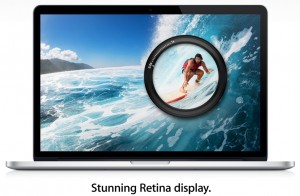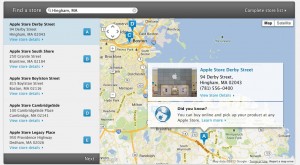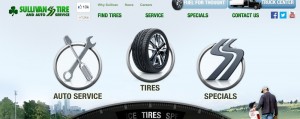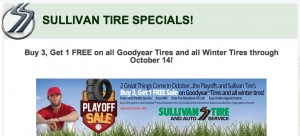Social Business Stories – Apple Store and Sullivan Tire
October 4, 2013
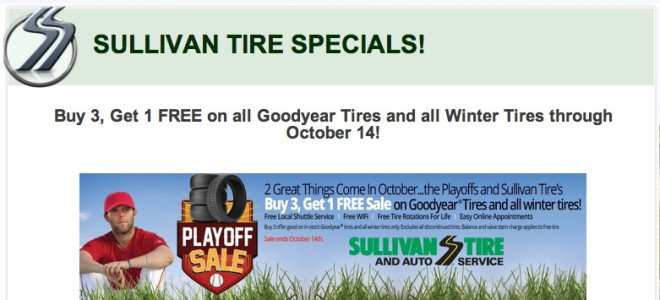
A social media blog talking about a social media-driven experience is always a bit of naval gazing, but where else am I going to share this information? In an age of new media, I’d be ill-advised to fax this story to my friends or pull out the banjo and sing songs about my customer service perspective. Maybe I’ll use it as fodder in my upcoming book, but for now I’ll share it here.
What’s the gist? Well, two brands with whom I have social media relationship almost failed me recently because they’ve forgotten how to perform customer service in real-world situations. Perhaps it’s because so much emphasis is now placed on multi-touch sales and moving customer interaction online. But in any case, my point today is that companies can’t forget how to work with a customer face-to-face.
[edit – added this paragraph to clarify my feelings for these brands lest some of you stop reading before the end of this post.] *Both companies get high marks in my book for working with me to make things right. And both Apple and Sullivan Tire remain two of my favorite companies to do business with because they listen to their customers and learn from customers’ experiences. I’m excited for my next Apple computer and for my next set of Sullivan Tire tires because of this fact.
Case-study 1. Apple Store at Derby Street Shoppes. Blue shirt doesn’t automatically make you qualified to work in an Apple Store.
I have a strong affinity for Apple devices. So much so that I have turned down jobs that required me to work on Windoze machines or with software that wasn’t compatible with Macintosh computers. Therefore, I have a real need to keep a positive relationship with local Apple store personnel – including the Genius Bar folks. This was never more clear than the other day when one of my Macintosh laptops died.
Knowing that repairing a dead laptop was beyond my technological prowess, I made a Genius Bar appointment online. That’s what you do. Go to the site, pick a time to stop by and then go to the Genius Bar for the folks in blue shirts to perform magic on your Macs. This time, I had an issue with my schedule.
Though my appointment was for 1PM, I showed up at 12 because I had another appointment across town and hoped I could sneak in early. This has worked in the past, but these days the Apple Store has a few issues complicating my strategy. These are…
1 – all the Genius Bar appointments are gobbled up quickly. In fact, when I logged on Monday to make an appointment, the earliest time available was Wednesday at 1PM.
2 – the Genius Bar now operates like a doctor’s office. Even if you arrive at your appointed time, you should be prepared to wait half an hour to see someone at the bar. They overbook spots and seemingly always run long. On one hand this is great because you’re getting good service. On the other hand, the notion of service blows chunks because seeing a specialist takes longer than anticipated which throws off your schedule for the whole day.
3 – Even with a sea of sales people in blue shirts, it’s increasingly difficult to find someone who can creatively address a customer service issue. Maybe it’s because the focus is on sales and not on customer service.
So, when I said to the second blue shirt (they accost you with a blue shirt at the door so they can send you to another blue shirt within the store) that I was early and wanted to try to get in to the bar before my appointment, he was befuddled. He said there had been no cancellations, so I’d have to wait the full hour until my appointment.
*Another problem with their system is that people now routinely make multiple appointments to account for the slow Genius Bar and the typical delayed start time. People also don’t cancel their reservations, so you never know if someone is showing for a reservation until they actually are ushered to the bar.
Faced with the prospect of cooling my heels for an hour, I asked if I could just leave the laptop for evaluation. The blue shirt said no, leaving a laptop was a liability issue and I couldn’t do that. I explained I had another appointment and would appreciate anything he could do to help me. He said he could get me in at my appointed time – clearly thinking that was doing me a favor. So I walked out and when he shouted after me I gave him a ‘talk-to-the-hand’ motion.
I then called the manager of the store from my car as I drove home. I told Tiffany I was disappointed that they didn’t have a solution for me…and I outlined my disappointment with the physical store because of the issues noted above. She apologized AND explained that they could take the computer in overnight and evaluate it. She said to ask for her if I had time to come back to the store. She also agreed that the person working the Genius Bar appointments wasn’t creative in his problem solving and customer service.
Ultimately, I made a second trip to the store. I got someone to look at my computer (without a Genius Bar appointment). And we determined a course of action that didn’t require leaving the laptop at the store. And it took less than 17 minutes.
Why the heck didn’t this happen when I was in the store before? Has customer service creativity gone the way of leash-law enforcement and the ability of people to follow a line queue at Starbucks? Which brings me to my TWO Sullivan Tire customer service stories.
Case Study 2. Sullivan Tire in Weymouth. Failure, success, failure and success. How much work do I have to do as a consumer to buy some tires?
I like Sullivan Tire. Not as much as I like Apple, but I have some connection with the Sullivan Tire brand and have made them my go-to store for basic car adjustments and tire sales. Both because they’re a local company and because they are active on social media have played into my habit of returning to them frequently. But two recent events almost made me take my business elsewhere…a breakdown in the appointment-making process and the lack of creativity (see a trend here) on the part of the sales person when interacting with a customer.
In the first event, I had a nail in a tire and needed it fixed. I jumped online to make an appointment at the local store and didn’t see that option. So I called the Sullivan Tire number to find out how long a wait it would be to get my tire repaired. When the auto prompts came on the phone, I stabbed at the first one that made sense, not realizing that the prompt to “speak to someone at the Weymouth location” was coming up.
My button press routed me to a call center where they don’t really know how many cars are on the lifts at the actual store. So when I told the woman on the phone I was leaving my house right then to go to the Weymouth store, she assured me that I would be seen right away. Not so. When I arrived at the location, I was told it would be more than an hour before they could look at my tire and repair it.
On the positive side, the guy at the counter said I could leave and come back in a little over an hour and they’d get me right in. I chose that course of action because it didn’t require me to abandon an hour of my day sitting in a waiting room at a tire place.
In fact, this arrangement was a positive one because the communication was clear after we both figured out that the call center had no real ability to make promises about timing at Sullivan Tire’s various stores. After speaking with a person at the main office, we determined that the phone prompts would be readjusted so that callers would immediately be aware they could speak with a person AT the actual store location.
In the second event, it was the people at the location (Weymouth Sullivan Tire store again) who failed to think about the needs of the customer first. To paint the scene…my wife had a nearly flat tire and knew that she probably needed four new tires. She dropped the car off before the store opened and then conducted her business via phone.
While people complain that new technology muddies the water of communication, it can also happen with technologies we’ve had for 100+ years like the phone. That’s what happened in this case.
When she spoke with a person in Weymouth, my wife made it clear that she didn’t want to spend a ton of money on new tires. The desk person – who had just finished telling her that she realistically needed four tires – said she could get away with buying two tires now instead of replacing all four immediately. He then looked for the least expensive tires for her and thought he was doing his job.
What you don’t realize is that on the radio and on signs at the property and even in the phone script at all Sullivan Tire stores during this period, there was a HUGE buy-three, get-one-free promotion going on. Never was this mentioned to my wife. This promotion when I explored it later in the day with a different desk person, would provide my wife with much better tires at a similarly low price.
The first desk person only heard the concern over price and didn’t even think about longterm value to the customer. If this was just obliviousness (though he had been answering the phone all day mentioning the tire special), or a lack of creative customer service, the result was almost the same. We could have looked at the transaction in a negative light because we’d surely be back in the store in a month buying two more tires for the back of her car.
Luckily, my phone call to the store to discuss tires and other repairs on her car was with a specialist who agreed that the tire promotion was a smarter way to go. He made a few phone calls on his end and located the tires that fit my wife’s car, and he ensured our allegiance to Sullivan Tire in at least the near term.
Lessons
Neither of these situations was earth-shattering. We would have been fine with a wonky computer (turns out I ripped it apart at home and put in a new hard drive – solving the problem for now); and two new tires would have been a good short-term solution. But by eventually going the extra mile and being a little more customer-centric in their thinking, both Apple and Sullivan retained our business for another day.
What I’d like to know is why I had to do so much work on my end to enable this process. If my interactions had been with lesser brands – or companies with whom I had no allegiance – my money and all future monies would be going into someone else’s pocket.
Even though a lot of our communication is now online and via social tools, losing sight of how to do business in real life can result in the loss of real dollars. I think that’s what Apple, Sullivan and all businesses have to realize these days. Customer service still wins and retains loyalty when done right.
What stories do you have to share about your adventures in customer service?


